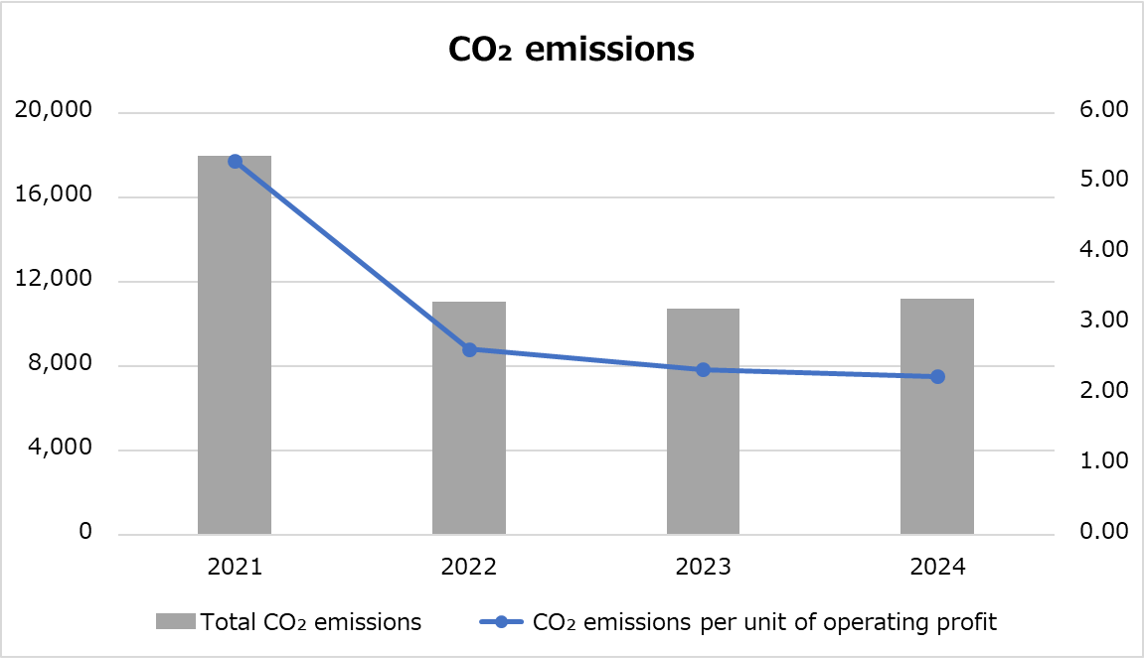We position action on climate change as an important issue for management and are committed to making disclosures around the four thematic areas of governance, strategy, risk management, and metrics and targets based on the TCFD recommendations.
1.Governance
The Company has established a Sustainability Committee, which is chaired by the Representative Director and President. The committee discusses policies and action plans for resolving issues related to sustainability in general and manages progress on addressing such issues. The results of the committee’s deliberations and other activities are reported to the Board of Directors and a structure for monitoring and supervision by the Board of Directors has been developed.
2.Strategy
We recognize the following as material risks and opportunities related to climate change.
To gain an understanding of the risks and opportunities stemming from climate change, we conducted scenario analysis based on two scenarios: a 1.5℃ scenario and a 4.0℃ scenario, with reference to the scenarios published by the Intergovernmental Panel on Climate Change (IPCC), the International Energy Agency (IEA) and other organizations.
| Category | Details | Action policies | |
|---|---|---|---|
| Transition risks | Policy and regulatory risks | Increased costs due to the introduction of carbon pricing and strengthening of laws and regulations |
・Reducing CO2 emissions through measures such as optimizing manufacturing processes and introducing more efficient equipment
・Utilizing renewable energy |
| Rising prices and procurement difficulties for certain materials due to regulation | ・Diversifying suppliers ・Developing new suppliers ・Considering and developing alternative materials
|
||
| Increased expenditure for investment in energy conservation and renewable energy | ・Investing systematically ・Actively utilizing subsidies |
||
| Reputational risks | Decline in corporate value or fewer sales opportunities due to late response or insufficient information disclosure |
・Reducing greenhouse gas emissions by promoting energy conservation and using renewables
・Enhancing information disclosure and strengthening dialogue with stakeholders
|
|
| Physical risks | Acute risks | Decrease in business site utilization rate due to sudden disaster |
・Achieving geographic business diversification
・Having multiple suppliers and ensuring the adequate levels of inventory levels in case of interruptions in the supply of raw materials
・Formulating BCP |
| Interruption of operations due to the impact of natural disasters on the supply chain | |||
| Instability in supplies of natural resources, water energy, raw materials and other materials | |||
| Chronic risks | Chronic climate changes (rising sea levels, rising temperatures, etc.) | ・Formulating BCP
・Promoting energy conservation activities
・Promoting in-house power generation including solar power generation
|
|
| Instability in supplies of natural resources, water energy, raw materials and other materials | |||
| Decreased precision in manufacturing processes due to rising temperatures and occurrence of additional temperature control costs | |||
| Opportunities | Energy conservation, decarbonization | Fewer CO2 emissions and lower costs as a result of the promotion of energy savings and the adoption of renewable energy |
・Optimizing manufacturing processes
・Investing in high efficiency equipment and solar power generation
|
| Products and Services | Enhancement of corporate image through the promotion of climate-related information disclosure |
・Enhancing information disclosure and strengthening dialogue with stakeholders
|
|
| Increased sales as a result of EV market expansion, and growth in demand for energy-saving products |
・Stepping up investment in the development of relevant products and strengthening production capacity
|
||
3.Risk Management
The Group takes measures to prevent risks from materializing based on discussions of the impact and order of priority of various risks identified by each business unit or across the group at a liaison meeting with the division heads and above every morning.
Climate-related risks are assessed and managed through cooperation and information sharing with the Sustainability Committee.
4. Metrics and Targets
We have set CO2 emissions as an indicator used to manage climate-related risks and opportunities and our actual CO2 emissions (Scopes 1 and 2) are as follows.

| Items | 2021 | 2022 | 2023 | 2024 | Target of 2030 |
|---|---|---|---|---|---|
| Total CO₂ emissions(t-CO₂) | 17,966 | 11,032 | 10,736 | 11,181 | Reduce CO2 emissions (Scope 1, 2) by 30% compared to 2023 |
| Operating profit(M yen) | 3,380 | 4,178 | 4,574 | 4,961 | |
| CO₂ emissions per operating profit (t-CO₂/M yen) |
5.32 | 2.64 | 2.35 | 2.25 |
※The figures presented above have been calculated using factors of the individual countries, based on energy consumption values at the head office (including sales offices and the R&D center), the Two factories in China and the Philippines Factory.(Kunshan Nicera Electrical Appliance Co., Ltd., which is a plant in China, withdrew from production in 2022.)
![日本セラミック株式会社 [Nippon Ceramic Co., Ltd]](https://www.nicera.co.jp/wordpress/wp-content/themes/nicera/img/logo-en.png)